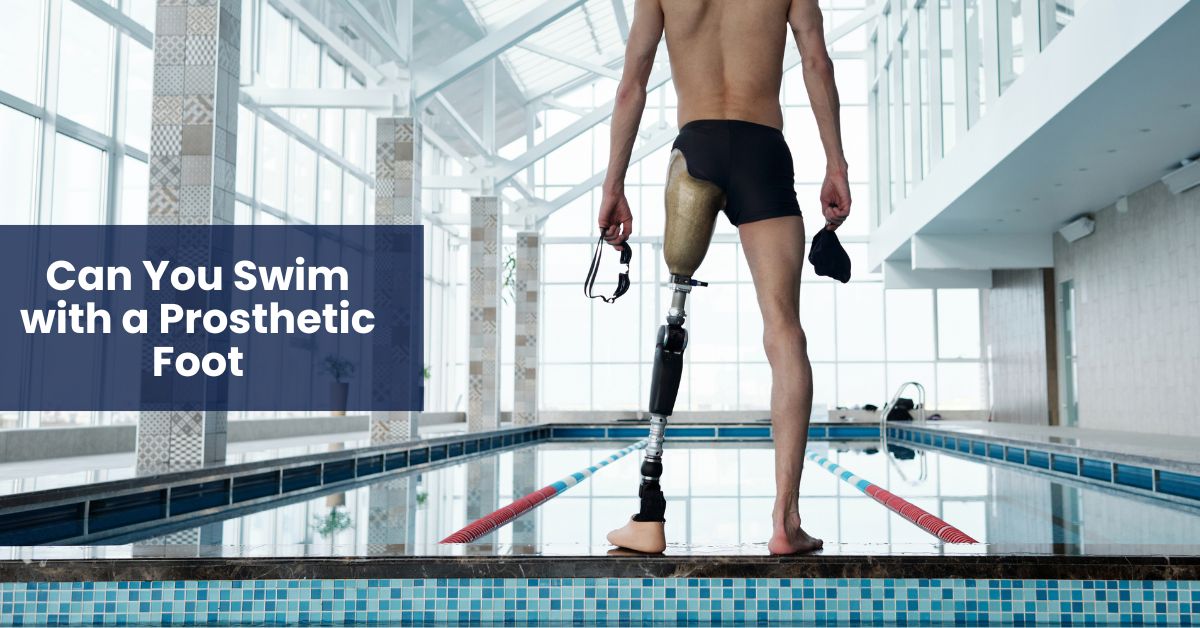“Can I swim if I have a prosthetic foot?” This is a common question among new prosthetic users or those thinking about getting back to water activities. The great news is — yes, many people with a prosthetic foot can swim safely and comfortably. Swimming is a wonderful way to stay active, improve fitness, and enjoy life. It might take a little time to get used to, but with the right approach, swimming is definitely possible.
Swimming with a prosthetic foot is not just about being in the water. It’s about feeling confident, safe, and free while you move. Some people prefer to swim without their prosthetic foot because water can sometimes damage regular limbs, or it may feel uncomfortable. Others use special waterproof prostheses designed for water activities. Either way, you don’t have to give up swimming just because of your prosthetic foot.
Swimming Without Your Prosthetic Foot
Many prosthetic users find it easier to swim without their artificial foot attached. Water offers natural buoyancy, which helps support your body weight, making movement easier and less stressful on your joints. If you feel comfortable and balanced, swimming without your prosthesis can give you a great full-body workout.
However, it’s important to be cautious when entering and exiting the pool or beach. Walking on slippery or uneven surfaces can be tricky without your prosthesis. Wearing water shoes or using handrails can help improve your safety.
If you decide to swim without your prosthetic foot, make sure to protect the limb’s skin and residual limb from irritation caused by water and chlorine. Rinsing with clean water after swimming and using a moisturizing lotion can help keep your skin healthy.
Swimming With a Waterproof Prosthetic Foot
For those who want to keep their prosthetic foot on while swimming, special waterproof prostheses are available. These are made with materials that resist water damage and are designed to be used in pools, lakes, or oceans. Some are even custom-made for swimming and water sports.
A waterproof prosthetic foot lets you feel more secure when walking around wet areas or in shallow water. It also helps maintain your natural balance while you swim. Plus, it can be more comfortable if you’re not used to swimming without your limb.
Keep in mind, these prosthetic feet may need regular maintenance to ensure they stay waterproof and function well. Checking with your prosthetist about care instructions is always a good idea.
Special Considerations for Swimming with a Prosthesis
Swimming with a prosthesis requires a few extra precautions to keep both you and your device safe and comfortable. First, it’s important to use a prosthetic foot specifically designed for water activities if you plan to swim regularly. These are made with waterproof materials that won’t get damaged by moisture, chlorine, or saltwater.
Before entering the water, check that all parts of your prosthesis are secure and functioning well. Keep in mind that water can affect your balance, so take your time moving in and out of the pool or ocean. Using a swimming prosthesis with a streamlined design can help you move more easily and naturally in the water.
After swimming, thoroughly rinse your prosthesis with fresh water to remove chlorine or salt, which can cause corrosion. Dry it completely before putting it back on or storing it to prevent skin irritation or damage to the device. Also, make sure to care for your residual limb by cleaning and drying it well to avoid any infections or discomfort.
Lastly, always listen to your body—if you feel any discomfort, swelling, or pain after swimming, consult your prosthetist or healthcare provider for advice. With these considerations in mind, swimming can be a safe, enjoyable, and freeing activity for prosthesis users.
Tips for Swimming with a Prosthetic Foot
If you’re planning to swim with or without your prosthetic foot, here are some helpful tips to keep in mind:
- Start slow and practice in shallow water before moving to deeper pools or open water.
- Use flotation aids if you’re new to swimming or still gaining confidence.
- Protect your residual limb with waterproof covers or sleeves if recommended.
- Always swim in safe, supervised areas, especially if you’re trying swimming for the first time.
- Communicate with your prosthetist about your swimming goals; they can help recommend the right prosthetic or accessories.
- Rinse off thoroughly after swimming to remove salt, chlorine, or sand that might irritate your skin or damage your prosthetic.
Why Swimming is Great for Prosthetic Users
Swimming offers many benefits for people with prosthetics. It is low-impact, meaning it doesn’t put too much strain on your joints or limbs. Water’s buoyancy supports your body weight, making movement easier and less painful. Swimming can help improve your strength, flexibility, balance, and cardiovascular fitness — all important for living well with a prosthesis.
Also, many people find swimming to be fun and freeing. Being in the water can boost your mood, reduce stress, and increase your confidence. It’s a great way to stay active without worrying about the challenges of walking or running on land.
Are There Special Prosthetic Feet Just for Swimming?
Yes, there are specially designed prosthetic feet made specifically for swimming and other water activities. These swimming prostheses are built using waterproof materials like silicone, carbon fiber, and stainless steel, which resist corrosion and damage caused by exposure to water, chlorine, and salt.
Unlike regular prosthetic feet, they don’t have components that can get ruined by moisture. Some models even have streamlined shapes or flexible features to help improve your movement and balance in the water.
These specialized prosthetic feet let you confidently enjoy swimming, snorkeling, or water sports without worrying about damaging your device. If you swim often or want to use your prosthesis in the water regularly, talking to your prosthetist about a waterproof swimming foot is a great option.
Will Swimming Damage My Prosthetic Foot?
Swimming with a regular prosthetic foot that isn’t designed for water can lead to damage over time. Most standard prostheses include parts made from materials that can corrode, rust, or degrade when exposed to moisture, saltwater, or chlorine.
Water can also affect the internal mechanisms, such as joints or connectors, causing them to wear out faster or malfunction. Additionally, chlorine in pools can be harsh on the prosthetic’s materials and the skin on your residual limb, increasing the risk of irritation or injury.
To prevent damage, many users remove their prosthetic foot before swimming or invest in a waterproof prosthesis designed specifically for water use. Proper cleaning, drying, and maintenance after water exposure are essential to prolong the life of your prosthetic foot and keep it functioning well.
Final Thoughts: You Can Swim with a Prosthetic Foot!
Whether you choose to swim with your prosthetic foot or without it, the most important thing is that you enjoy the experience and stay safe. Many prosthetic users around the world swim regularly and lead active lives in and out of the water. With the right preparation, practice, and support, swimming can be a wonderful part of your fitness routine.
If you’re interested in swimming, talk to your prosthetist or physical therapist about your options. They can help you find the best prosthetic for water use or suggest techniques to build your confidence. Remember, every person’s journey is unique, so be patient with yourself and celebrate every small step forward. Soon, you’ll be making a splash and enjoying the water like never before!
Disclaimer:
The information provided in this blog is for general educational purposes only and should not be considered medical advice. Always consult with your doctor, prosthetist, or physiotherapist before making decisions related to your health, rehabilitation, or prosthetic use. Every individual’s condition and needs may vary.








